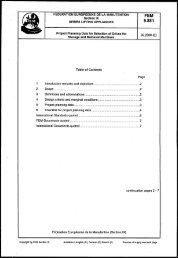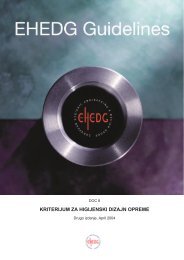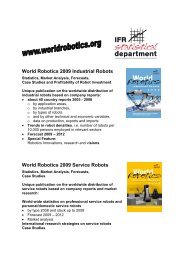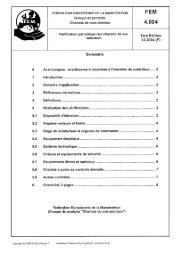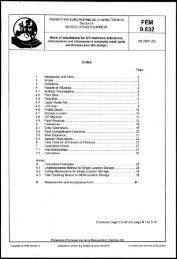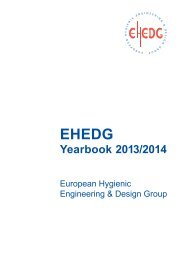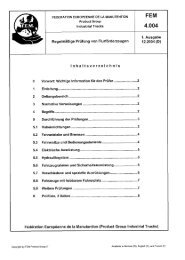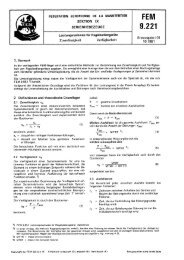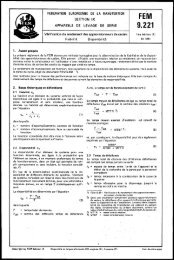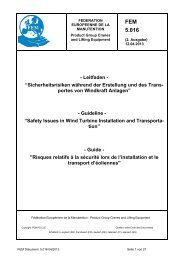FEM 9.311
FEM 9.311
FEM 9.311
Create successful ePaper yourself
Turn your PDF publications into a flip-book with our unique Google optimized e-Paper software.
Since the stresses to which the structure is subjected aredirectly proportional to the dynamic deformations, theoscillation coefficient Swmax = 2 must be used forfurther calculations of deformations, stresses, and stress. resultants.2.1.4.2 Effect of horizontal forces of inertiaWithout the coefficients l{) and t/J according to section2,1.3 but with the oscillation coefficient according tosection 2.1.4.1, the dynamic effects of the masses resultingfrom structure flexibility shall be assumed to beappl ied to the individual centres of gravity (5, • 52. 53.etc.).Example':F, horizontal dynamic force of acceleration due to theload unit and the weight of the lifting carriageF 2F 3horizontal force of dynamic acceleration due to thedistributed load of the masthorizontal force of dynamic acceleration due to theweight of bottom carriage, travel mechanism andattachments (e. g. control cubicle, hoist mechanism,etc.)The masses shall: be considered according to their distributionin each particular case.Figure 3.-.F1/VlA\~-"-----'R min = R statF,xh,+ F 2 xh 2 + F 3 xh 3r<strong>FEM</strong> <strong>9.311</strong> Page 3For SIR machines, the stability is defined as follows:Stability:v =L stabilising momentSL overturning momentsR.tatx rThe stability v shall be ~ 1.5 under service conditions;in exceptional situations, e. g. for emergency braking, itshall be at least 1.1 (leaving the safety claws out of consideration).For SiR machines which are positively prevented fromtilting (e. g. by positively guided travel wheels), thestability analysis is omitted if· the negative wheel loads. are completely absorbed by the guiding members andtransmitted to the rack or building structure.2.1.4.3 Friction force coefficient Ji.,The driving forces on the travel wheel periphery arelimited by the friction coefficient applicable to thetravel wheel/rail pair. .The driving force which can be continuously transmittedis thus ~ R min x J.L. For steeH~n-steel pairs,J.L = 0.2 shall be used as a maximum...'N.r:::.F2t-S22.1.4.4 Lateral forces SzIf, due to forces of inertia, lateral forces occur transverselyto the runway centre line, these shall be transmittedto the rails by form and friction grip in linewith the.guiding members and the systems of thestructure and travel mechanism.rn I, F 3s~.r:::.I't-.IRlDepending on the direction of acceleration, the dynamicforces of inertia tend to increase or to decrease the wheelloads R, and R 2 .F, = (mL + mH) x 2 x am,F 2where:,mLmHmsmemAam=. m. x 2 x ·a m •F 3 = (me + mAl x am,mass of the load unitmass of the lifting carriagemass of the mastmass of bottom carriagemass of the attachments to the bottom carriagemean accelerationrsince Swsince Swsince SwR2221 (unsprung)2.2 Categories of additional loads2.2.1 Forces due to running askewDepending on the systems of travel mechanism andstructure, form grip forces are produced which acton the guiding members (wheel flanges or guide rollers)of an SIR machine by running' askew at an angle a,and from these frictional rubbing forces result whichact on the contact surfaces of the travel wheels.For the generally accepted tolerances of travel wheeldiameter, parallelism of the wheel bore axes and runwayalignment, a linear law of friction forces appliesto the longitudinal and transverse slip of two travelwheels of ferrous material on a steel rail:where:f = 0.30 x (1 _ e- O ,25x a)e = base of the natural logarithms 2.71828a = angle of skew in 0/00



